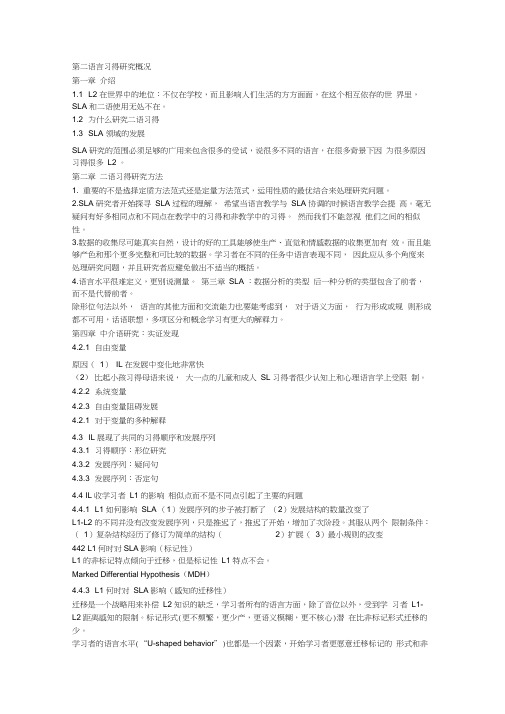Unit 1 Introduction SLA(1)二语习得简介
SLA 第二语言习得

Contrastive Analysis Contrastive analysis: the systematic study of the differences between the mother tongue and the target language and their influence upon each other so as to determine what the learner has to learn and what the teacher has to teach.
Error Analysis
A major claim of Error Analysis is that many errors made by L2 learners were caused by factors other than L1 interference.
Interlanguage(中介语言)
8
Individual differences
Language aptitude Motivation Learning strategies
Language Aptitude
• It refers to a natural ability for a second language. It is believed to be related to a learner’s general intelligence.
✿Cognitive strategies ✿Metacognitive strategies ✿Affect/social strategies
Age of Acquisition
Children from immigrant families achieve comparatively higher level of mastery of the new language than their parents do. Adult second language learners become capable of communicating successfully in the target language.
1、二语习得概述

08对外汉语专业
3
一、母语与目的语
1、母语,native language
母语——指的是学习者幼年习得的语言。由于母语是家 庭或者所属种族、社团使用的语言,因而也称作“本族 语”。
一般说来,母语通常是儿童出生以后最先接触、学会的 语言。因此,母语通常也被称作“第一语言”,first language。
语言学习是指有意识地学习语言知识,能够明确地意识 到所学的规则。Krashen 把通过这两个方式获得语言的 过程看作彼此独立的学习过程。
08对外汉语专业
7
与“习得”“学习”相关的概念
习得
学习
implicit
内隐学习
learning
informal
onscious 下意识学习
母语与第一语言不一致的情况
在国外出生的汉族儿童 他接触的“第一语言”不是汉语,而是出生地社团所
说的语言,比如,英语;
在这种情况下,英语是他的“第一语言”;
但是,英语并不是他的母语,他的母语或本族语是汉 语。
08对外汉语专业
4
2、学习者的目的语,Target language
“目的语”,也称“目标语”; 一般指的是“学习者正在学习的语言”。这种语言可能是 他的第二语言、第三语言甚或第四语言。 对于学习者来说,目的语与其母语或第一语言是一对对 应的概念。它强调的是学习者正在学习的母语之外的任 何一种语言。
08对外汉语专业
5
二、第一语言与第二语言
“第一语言”通常是指学习者的母语或本族语而言的。尽管有 些时候,学习者的第一语言并不是他的母语或本族语。
“第二语言”是相对于学习者习得的第一语言之外的任何一种 其他语言而言的,Ellis (1994)。因此,“第二语言”自然包
SLA_二语习得重要问题总结

SLA 期末考试提纲Week 9Chapter 1 Introducing Second Language AcquisitionChapter 2 Foundations of Second Language AcquisitionPART ONE:Definition:1.Second Language Acquisition (SLA): a term that refers both to the study of individualsand groups who are learning a language subsequent to learning their first one as young children, and to the process of learning that language.2.Formal L2 learning: instructed learning that takes place in classrooms.rmal L2 learning:SLA that takes place in naturalistic contexts。
4.First language/native language/mother tongue (L1): A language that is acquirednaturally in early childhood,usually because it is the primary language of a child's family。
A child who grows up in a multilingual setting may have more than one “first”language.5.Second language (L2): In its general sense,this term refers to any language that isacquired after the first language has been established. In its specific sense,this term typically refers to an additional language which is learned within a context where it is societally dominant and needed for education, employment,and other basic purposes.The more specific sense contrasts with foreign language,library language, auxiliary (帮助的,辅助的)language,and language for specific purposes。
第二语言习得之概论

第二语言习得之概论首先,第二语言习得与第一语言习得有所不同。
第一语言习得是指婴儿从出生开始,通过听、说等方式自然而然地掌握母语的过程。
相比之下,第二语言习得是指在已掌握一种语言的基础上,学习并使用另一种语言。
学习一门新的语言需要借助外部资源,如教材、教师等。
在第二语言习得的研究领域,有许多理论来解释这个过程。
其中最著名的是克拉申提出的输入假设和通信策略假设。
输入假设认为学习者只能通过大量和适度难度的输入来习得第二语言。
而通信策略假设则关注学习者为了完成交际目标而使用的一系列策略。
另外,还有赖尔森-强度假设认为情感和情绪因素对第二语言习得起到重要作用。
第二语言习得的过程受到多个因素的影响。
首先,个体差异是一个重要的因素。
不同人对语言习得的天赋和能力各不相同。
例如,有些人天生对语音的敏感度较高,可以更容易地习得发音。
其次,语言输入的质量和数量也会对第二语言习得产生影响。
学习者需要接触到足够地有意义和丰富的语言输入。
此外,社会因素也是一个重要因素。
学习者所处的语言社群以及相关的文化因素都会对语言习得产生影响。
第二语言习得的策略也是一个重要的研究领域。
学习者使用各种策略来帮助他们习得第二语言。
例如,重组策略是指学习者将已知的语言元素重组成新的语言形式。
还有输出策略,即通过使用新学的语言来练习和巩固。
这些策略可以提高学习效果,帮助学习者更快地习得第二语言。
除了理论和策略,教学方法也是第二语言习得中的重要因素。
传统的语言教学方法主要以教师为中心,注重语法规则和翻译。
而现代的语言教学方法更加注重学习者的积极参与和真实交际。
例如,交际法和任务型教学法强调学习者在语境中进行真实的交际实践。
总而言之,第二语言习得是一个复杂的过程,涉及到个体差异、语言输入、社会因素等多个方面的因素。
理解这些因素对于发展有效的教学方法和实施有效的第二语言习得计划非常重要。
希望本文的介绍能够帮助读者更好地了解第二语言习得的概论。
第二语言习得 (中文版)

第二语言习得 (中文版)第二语言习得是指在已经谙熟自己的母语后开始接触学习另外的一门语言。
这种语言习得与母语习得不同,因为母语即是个人的文化和生活背景的一部分,而第二语言则需要通过各种学习环境、工具和方法才能够完成。
第二语言的学习有其特殊性,因为它需要不同的學習技巧或是包含不同的学习过程。
而且,因为第二语言的习得通常是在成人的时期开始的,所以这种语言习得需要分析并改变人的思维方式习惯。
就像一个中国人学英语,需要用到英语的语法规则,同时又逃不掉中文惯用的方式和表达方式。
为了掌握第二语言,我们需要通过各种途径去了解和学习它。
这些途径包括学校、网上资源、语言交流等等。
最好的途径当然是去一个使用第二语言的国家,并在那里生活,这样可以最好的体验到语言的环境,也能适应新的生活和文化。
对于那些没有这个机会的人,透过各种在线资源来学习和练习也是同样有效的。
第二语言习得可能会改变我们的思维方式和认知水平。
通过学习这门外语,我们可以认识不同的语言文化和习惯,扩宽自己的眼界。
同时,通过不同语言的丰富表达方式,也可以更加深入的理解和描述世界。
第二语言的习得也会对我们的就业竞争力产生积极影响。
因为在全球化的时代背景下,英语已经成为商业和学术合作的重要语言。
如果我们能够掌握这种第二语言,我们的就业机会和工作效率也会更高。
总之,第二语言习得是非常重要和有价值的。
这种习得需要时间、耐心和努力。
不过通过积极的学习和交流,我们能够顺利掌握一门外语,并获得更多的机会和认知。
第二语言习得的过程通常被认为是相对困难的,原因在于以下一些方面。
首先,个体的母语背景、学习历史和文化习惯对于学习另一门语言的效果产生重要影响。
这些因素往往会阻碍个体从母语中摆脱出来进入到新学习的语言环境中。
其次,学习语言的词汇和语法规则是一个长期而复杂的过程。
除了需要内化表达方式外,学习者还需要理解并适应新的文化习惯和社会背景。
而这种适应需要耗费大量的时间和精力。
第一章 二语习得研究概述

二、一个独立的交叉学科(跨学科特点)
研究对象的性质
决定
跨学科的性质
1.学习者语言系统的研究
2.语言获得的一系列心理过程
3.学习者自身的研究
新领域:关于学习者本身的研究
主要包括两个方面:
(一)汉语学习者的策略研究,如学习策略和交际策 略,汉字学习策略 (二)汉语学习者汉语个体差异因素的研究,如态度、 动机,语言能力倾向、学习焦虑因素
汉语认知研究(语音、词汇、汉字) 海外习得研究
第二章 对比分析与偏误分析
第一节 对比分析
1.定义:将两种语言的系统进行共时比较,以揭示其 相同点和不同点的一种语言分析方法。
偏误来源
1)母语负迁移 2)目的语知识迁移 过度概括/过度泛化 3)文化因素负迁移 4)学习策略和交际策略的影响 学习策略方面:迁移、过度泛化、简化 交际策略方面:回避、语言转换 5)学习环境的影响
5)评估偏误:对偏误分析的标准进行评估 哪类偏误问题更严重 母语者和非母语者对偏误的评估不同 评估标准问题
国外大部分学者不刻意区分这两个概念,认为可以互
相替代,因此产生了“第一语言习得” “第二语言
习得”或“自然状态下的语言习得” “教学环境下
的语言习得”。
但国内学者试图严格区分两种不同的方式
母语习得
二语学习(学得) 有意识 有(课堂讲授) 有计划 有教材 通常无,非自然环境 有序输入 注重形式
学习
明晰的 有意识的 explicit learning formal learning conscious learning knowing about a language
第二语言习得基础知识

第二语言习得基础知识在当今全球化的时代,掌握一门第二语言变得越来越重要。
无论是出于工作需要、学术追求还是个人兴趣,学习第二语言都为我们打开了更广阔的视野和更多的机会。
那么,什么是第二语言习得?它又有哪些关键的基础知识呢?首先,我们要明确第二语言习得的定义。
简单来说,第二语言习得指的是人们在已经掌握了第一语言(通常是母语)之后,通过学习和使用来掌握另外一种语言的过程。
这个过程不仅仅是词汇和语法的积累,还包括语音、语调、语言运用的习惯以及文化背景的理解等多个方面。
语言环境在第二语言习得中起着至关重要的作用。
一个丰富的语言环境可以为学习者提供大量的语言输入和实践机会。
比如,如果一个人生活在一个以英语为主要交流语言的国家,那么他每天都会接触到英语,听到各种不同的口音和表达方式,这对于他的英语习得是非常有帮助的。
相反,如果只是在课堂上学习英语,缺乏真实的语言环境,那么学习效果可能会大打折扣。
年龄也是影响第二语言习得的一个重要因素。
儿童在语言习得方面往往具有优势。
他们的大脑更具可塑性,能够更轻松地模仿语音和掌握语法规则。
而且,儿童在学习语言时通常不会受到第一语言的强烈干扰,更容易形成地道的语言习惯。
然而,成年人也并非没有机会学好第二语言。
成年人具有更强的认知能力和学习策略,能够更有针对性地进行学习。
动机是推动第二语言习得的内在动力。
如果一个人学习第二语言是出于强烈的内在动机,比如对目标语言的文化感兴趣、渴望与更多的人交流,那么他往往会更有积极性和主动性,学习效果也会更好。
相反,如果只是为了应付考试或者迫于外界压力而学习,那么一旦失去了这些外部因素的驱动,学习很可能就会停滞不前。
学习策略在第二语言习得中也不可忽视。
好的学习策略可以帮助学习者更高效地学习。
例如,制定学习计划、多听多读多说多写、利用各种学习资源(如电影、歌曲、书籍等)、与母语者交流等等。
同时,学习者还要不断反思自己的学习方法,及时调整策略,以适应不同的学习阶段和学习内容。
第二外语习得(SLA)--浅析如何将语言学方法推送到基础德语课堂上

2.
文 化 差 异 :因为历史与文化的不同,造就了一批具有自
德 语 过 程 中 ,将语言学方法引入基础德语课堂时是所得到的收 己民族文化特色的词汇:族 谱 、红娘、对 联 。
获 ,以及学生利用语言学方法的学习成效。
3.
表 达 差 异 :对 于 同 一 事 物 ,不同民族会有自己不同的表
关 键 词 :语 言 学 ;二 语 习 得 ;音 位 学 ;语 义 学 ;词 法 学 ; 达 方 式 :晒 斑 __Sonnensprosse, 红 茶 一 schwarzer Tee。
3.
德语中存在一些与汉语因素极易混淆的音素,但是在发离 了 文 化 不 可 能 真 正 认 识 到 一 门 语 言 的 内 涵 。语 言 其 实 是 大
声 过程中,用力强度和口型是不同的。
量 词 汇 堆 积 而 成 的 ,只 有 认 识 其 中 本 质 与 内 涵 ,才能够真正
4.
德语的各个因素可以单独发音,而汉语的辅音一般会自运 用 一 门 语 言 。对 于 外 语 文 化 的 缺 失 ,必 然 会 阻 碍 外 语 学 习
列 的 描 述 肢 体动作的动词,而这些动词在德语中可以直接用一
其 次 ,汉语与德语发音方法还各有特点:
个 简 单 动 词 tragen替 代 :
1.
德语中有清音与浊音的区别,但却没有送气和不送气音 从 跨 文 化 交 际 的 角 度 看 ,学 习 外 语 绝 不 仅 仅 只 是 学 习 其
的区分。
句法学
4.
比 喻 手 法 的 差 异 :每 个 民 族 都 有 十 分 具 有 自 己 特 色 的 想
象 力 ,比 如 在 德 语 中 HasenfuB(胆 小 鬼 )但其实直译过来的意思
Unit 1 Introduction SLA(1)

external factors: E.g. interaction---teacher talk Ss different levels of proficiency Adjustments in pronunciation/lexis/grammar (Henzl, 1979; Long, 1983)
Background 3
SL /FL teaching offers a big market in the world, particularly English teaching. It needs some theories to guide, particularly after WW II.
1. What do second language learners acquire? Describing (what) Interlanguage/fossilization/errors describing the behavior and developing systems of learner learning a new language collect samples/describe the main features/inspec A discipline that covers linguistics, psychology, education, sociolinguistics, psycholinguistics, neurolinguistics… --- an interdisciplinary study
The four questions serve as heuristic for exploring SLA research and help researchers identify a number of key issues.
第二语言习得的理论与实践

第二语言习得的理论与实践第二语言习得(Second Language Acquisition,SLA)是指个体在母语习得之后,对另一种语言的学习和掌握过程。
这一领域涉及心理学、语言学、社会学等多个学科,旨在探究学习者如何在不同环境下有效地习得第二语言。
本文将介绍几种主流的第二语言习得理论,并探讨其在实际教学中的应用。
行为主义理论行为主义理论认为语言习得是一个习惯形成的过程。
通过刺激-反应机制,学习者对环境中的语言输入做出反应,并逐渐形成正确的语言习惯。
在教学中,这一理论强调模仿和重复练习,如语音训练和句型操练,以帮助学生形成正确的语言习惯。
认知理论认知理论强调学习者内部心理活动的作用,认为语言习得是一个信息处理的过程。
学习者需要对输入的语言材料进行加工、储存和提取。
在教学上,认知理论倡导有意义的学习任务和策略训练,鼓励学生通过解决问题来学习语言。
社会文化理论社会文化理论认为语言习得是社会互动和文化参与的结果。
学习者在与他人的交流中逐步掌握语言。
这一理论强调社会环境的重要性,提倡使用真实的语言材料和情境,鼓励学生通过合作学习和角色扮演等活动提高语言能力。
输入假说输入假说由斯蒂芬·克拉申提出,主张学习者通过理解略高于当前水平的语言输入(i+1)来习得语言。
在教学实践中,这意味着教师应提供足够多的可理解输入,如听力和阅读材料,以促进学生的语言发展。
输出假说输出假说由梅瑞尔·斯温提出,强调语言产出在语言习得中的作用。
学习者通过尝试使用目标语言来检验自己的假设,并通过反馈进行调整。
教学中,鼓励学生积极参与口语和写作练习,以提高他们的语言能力。
应用实例在实际教学中,教师可以根据不同的理论设计教学活动。
例如,根据行为主义理论,可以设计模仿练习;根据认知理论,可以设置问题解决任务;根据社会文化理论,可以组织小组讨论;根据输入假说,可以提供大量的阅读材料;根据输出假说,可以安排演讲和写作作业。
第二外语习得(SLA)

第二外语习得(SLA)作者:刘帅阳来源:《神州·下旬刊》2017年第01期摘要:语言学是研究不同语言之间内在关系的学问。
本文将从三各方面论述。
第一部分简述学习第二外语方法,是整篇论文的理论引导。
第二部分以分析德语与汉语在语音学、语义学、词法学和句法学中的差异为中心,对汉语以及德语的语言学进行简述,并对比其差异。
最后一部分,详细讲述了在教授德语过程中,将语言学方法引入基础德语课堂时是所得到的收获,以及学生利用语言学方法的学习成效。
关键词:语言学;二语习得;音位学;语义学;词法学;句法学1.第二语言习得概念第二语言习得(Second Language Acquisition /SLA,简称二语习得),通常指母语习得之后的任何其他语言学习。
人们从社会、心理、语言学等角度去研究它。
第二语言习得研究作为一个独立学科,大概形成于二十世纪60年代末70年代初,已有35年的历史。
它对学习者的第二语言特征及其发展变化、学习者学习第二外语时所具有的共同特征和个别差异进行描写,并分析影响二语习得的内外部因素。
与其他社会科学相比,二语习得研究是个新领域,通常借用母语研究、教育学研究或其他相关学科的方法。
概括地说,这一领域的研究是为了系统地探讨二语习得的本质和习得的过程,其主要目标是:描述学习者如何获得第二语言以及解释为什么学习者能够获得第二语言。
2.汉、德语言学的比较2.1 语音学和音位学汉语与德语在发音部位和发音方法上有很大的区别。
因此,学习德语必须要先适应德语发音习惯。
汉、德两种语言中,在辅音发音方面有巨大的不同。
首先,汉语没有一些音素:其次,汉语与德语发音方法还各有特点:1. 德语中有清音与浊音的区别,但却没有送气和不送气音的区分。
2. 德语在发音过程中,口型一般要比汉语动作大、用力,发音部位肌肉紧张度更高。
3. 德语中存在一些与汉语因素极易混淆的音素,但是在发声过程中,用力强度和口型是不同的。
4. 德语的各个因素可以单独发音,而汉语的辅音一般会自带一个尾音。
二语习得知识梳理

Second Language Acqu isition /SLA第二语言习得(简称二语习得),通常指母语习得之后的任何其他语言学习。
人们从社会、心理、语言学等角度去研究它。
第二语言习得研究作为一个独立学科,大概形成于二十世纪60年代末70年代初,已有35年的历史。
它对学习者的第二语言特征及其发展变化、学习者学习第二外语时所具有的共同特征和个别差异进行描写,并分析影响二语习得的内部因素和外部因素。
与其他社会科学相比,二语习得研究是个新领域,大都借用母语研究、教育学研究或其他相关学科的方法。
概括地说,这一领域的研究是为了系统地探讨二语习得的本质和习得的过程,其主要目标是:描述学习者如何获得第二语言以及解释为什么学习者能够获得第二语言。
到目前为止,二语习得的研究范围远比20世纪七八十年代广,涉及语言学、心理学、心理语言学、语用学,社会语言学等众多方面。
早期的第二语言习得理论是教学法的附庸,为服务提高教学质量而存在,1967年Larry Selinke r在《语言迁移》这本专著第一次提出中介语理论,第二语言习得理论从此有了自己的研究领域而开始成为一门独立的学科。
现时的第二语言习得研究涉及三大领域,即中介语研究,学习者内部因素研究和学习者外部因素研究。
1994年美国费城Temple 大学教育学院二语英语教学教授Rod Ellis撰写巨著《第二语言习得研究》,成为该领域的经典教科书。
该书共分七个部分。
第一部分勾画了整本书的概念框架。
第二部分总结了有关学习者语言本质的主要理论,包括学习者错误,发展模式,语言变项和语用特征。
第三部分从外部因素解释第二语言的习得,主要阐述社会因素和输入/交互的作用。
第四部分从内部因素解释第二语言的习得,包括语言迁移、认知论解释和语言普遍性。
第五部分将讨论的重点从学习转移到学习者,论述了第二语言习得的个体差异和学习策略。
第六部分是关于课堂英语教学的论述,讨论了课堂交互和正规教学的有关理论。
《第二语言习得研究》全书概要 (知识点全)

《第二语言习得研究》全书概要第一章绪论第一节第二语言习得的一般概念第二语言习得(second language acquisition),简称SLA,是指人们在获得母语(第一语言)的基础上习得另一种或几种语言的过程。
也叫“二语习得”。
一、母语与目的语母语指学习者所属种族、社团使用的语言,也称作“本族语”。
目的语,也叫目标语,一般指学习者正在学习的语言。
二、第一语言与第二语言第一语言指儿童幼年最先接触和习得的语言,在此后习得的语言就是第二语言。
三、习得与学习克拉申(Krashen)认为成人L2学习者有两种独立的语言获得方式,两者在获得方式、心理过程、所获得的知识类型、作用等方面都不同Krashen认为,习得的知识与学得的知识是相互独立的两种知识。
学得的知识无法转换成习得的知识。
即所谓“无接口观点”(non-interface position)。
自然习得研究的证据表明,在习得情况下并未发生学习的过程,有时候,学习者可以先学会某个规则,但是并没有习得这个规则。
也就是说学习过程并不一定导致习得过程的发生。
无接口观点的证据:Seliger(1979)的证据:他让在课堂上让学习者描述一些图片,然后分析这些学习者使用冠词a与an的情况;此外,他让这些学习者陈述关于冠词用法的相关规则。
调查分析表明,学习者的实际语言表达与其元语言知识不相关。
也就是说,“习得”与“学习”的确是彼此独立的。
第二语言习得是指学习者在目的语国家学习目的语。
外语习得指学习者所学的语言在本国不是作为整个社团的交际工具,而且学习者所学的语言主要是在课堂上学习的。
五、自然的第二语言习得与有指导的第二语言习得:前者指在自然的社会环境下以交际的方式获得第二语言;后者指在课堂教学环境中以教学指导的方式获得第二语言。
语言能力是一种反映交际双方语言知识的心理语法。
语言表达指交际双方在语言的理解与生成过程中对其内在语法的运用。
一、第二语言习得研究与语言学:语言学是一个古老的学科,第二语言习得研究则是一个年轻的学科。
第二语言习得研究概述

2、社会语言学及其研究范式对第二语言习 得研究的影响,构成了第二语言习得研究 的社会语言学视角。 从心里语言学角度转向越来越关注社会因 素对第二语言学习者语言习得的影响。
3、认知科学对第二语言习得研究的影响构 成了第二语言习得研究的认知视角。即基 于认知加工理论框架的第二语言习得研究。
4、第二语言习得研究的社会文化视角。社 会文化学习理论强调社会文化与交际在语 言习得与认知过程中的重要作用。 按照这种理论,第二语言习得被看作在 社会交际中由“系统发生”到“个体发生” 的过程,换句话说,第二语言习得过程是 由社会化到学习者个体内在心理机能获得 的过程。
我国的SLA语言习得研究
在我国,SLA研究起步较晚,在70年代末和 80年代初才开始重视SLA的研究。研究基本上 是利用对比分析的方法进行汉外对比,主要目 的是发现汉语与外语的异同,预测第二语言学 习者所犯错误和难点,改进外语教学和教材的 编写。 汉语作为第二语言的研究起步更晚,对外汉 语与教学理论最初偏重的是汉语本体的研究。 Nhomakorabea
上世纪70年代,第二语言习得研究已经发展成 为一个独立的研究领域。
这个时期是第二语言习得研究理论大发展的阶段, 对比分析衰落之后,偏误分析应运而生, Lightbown (1985) 指出,在第二语言习得研究领域, 学者们大都把Corder 1967年发表的 “The significance of leaners’ errors” 以及Selinker 1972发 表的 “Interlanguage” 这两篇文章看作这个学科建 立的标志。
学者们之所以把这两篇文章作为这个学科建立的 标志,是因为: Corder第一次从理论上阐述了第二语言学习者的 语言偏误对语言教学、习得过程研究以及第二语 言学习者的重要意义。 Corder的观点从根本上改变了以往人们对待第二 语言学习者语言偏误的看法和态度。
二语习得介绍1

NNS: I need you to write a recommendation for me.
Second Language Acquisition: An Overview
III. Issues in SLA
the role of the first language the “natural” route of development individual learner differences the role of input learner processes the role of formal instruction
Second Language Acquisition: An Overview
I. What is Second Language Acquisition (SLA)? 2. The Definition of SLA:
the process learning another language after the learning of the native language second language (L2) any language learned after learning the L1 L2 can refer to non-native language learnt after the L1 acquisition, regardless of whether it is the second, third language.
I. What is Second Language Acquisition (SLA)? 2. The Definition of SLA:
the process learning another language after the learning of the native language (both in naturalistic and instructed setting) foreign language acquisition the learning of a nonnative language in the environment of one’s native language (mainly in instructed setting)
第二语言习得研究概况-读书笔记

第二语言习得研究概况第一章介绍1.1 L2 在世界中的地位:不仅在学校,而且影响人们生活的方方面面,在这个相互依存的世界里,SLA 和二语使用无处不在。
1.2 为什么研究二语习得1.3 SLA 领域的发展SLA 研究的范围必须足够的广用来包含很多的受试,说很多不同的语言,在很多背景下因为很多原因习得很多L2 。
第二章二语习得研究方法1. 重要的不是选择定质方法范式还是定量方法范式,运用性质的最优结合来处理研究问题。
2.SLA 研究者开始探寻SLA 过程的理解,希望当语言教学与SLA 协调的时候语言教学会提高。
毫无疑问有好多相同点和不同点在教学中的习得和非教学中的习得。
然而我们不能忽视他们之间的相似性。
3.数据的收集尽可能真实自然,设计的好的工具能够使生产、直觉和情感数据的收集更加有效。
而且能够产色和那个更多完整和可比较的数据。
学习者在不同的任务中语言表现不同,因此应从多个角度来处理研究问题,并且研究者应避免做出不适当的概括。
4.语言水平很难定义,更别说测量。
第三章SLA :数据分析的类型后一种分析的类型包含了前者,而不是代替前者。
除形位句法以外,语言的其他方面和交流能力也要能考虑到,对于语义方面,行为形成或规则形成都不可用,话语联想,多项区分和概念学习有更大的解释力。
第四章中介语研究:实证发现4.2.1 自由变量原因(1)IL 在发展中变化地非常快(2)比起小孩习得母语来说,大一点的儿童和成人SL 习得者很少认知上和心理语言学上受限制。
4.2.2 系统变量4.2.3 自由变量阻碍发展4.2.1 对于变量的多种解释4.3 IL 展现了共同的习得顺序和发展序列4.3.1 习得顺序:形位研究4.3.2 发展序列:疑问句4.3.3 发展序列:否定句4.4 IL 收学习者L1 的影响相似点而不是不同点引起了主要的问题4.4.1 L1 如何影响SLA (1)发展序列的步子被打断了(2)发展结构的数量改变了L1-L2 的不同并没有改变发展序列,只是推迟了,推迟了开始,增加了次阶段。
第一讲 第二语言习得及其研究概述 (1)

母语
第一语言
粤语
方言
第二语言 特定的语言学习过程
法语
朝鲜语
第二语言
外国语
外国语或外族语
武汉大学文学院对外汉语专业本科课程
武汉大学文学院对外汉语专业本科课程
( 1)第一语言是个人身份的标志,总体水平也高于第二语言。 ( 2)第二语言一定是外语。 ( 3)一个人从小就会两三种语言,如何区分哪个是第一语言, 哪个是第二语言? ( 4)一个人母语是西班牙语, 7岁到中国,然后开始学汉语,长 大后居住在北京,以汉语为主要的交流方式。 请问这个人的 西班牙语和汉语相互之间是什么关系?
欧阳晓芳《第二语言习得导论》
2012/9/6
SWBAT
第二语言习得导论
授课人:欧阳晓芳 Email:tcasl.oy@
时间:周一上午9:50 地点:理工楼202
武汉大学文学院对外汉语专业本科课程
了解第二语言习得研究的历史、现状、发展趋势 ; 认识第二语言习得与其他研究领域的关系,学会从语言学、心 理学和社会学等不同的视角来认识二语习得; 掌握一些基本的第二语言习得理论和研究方法; 在学习过程中开始形成自己的教学和研究思路, 为今后的对外 汉语教学实践或作二语习得研究打下一定的基础 。
(guided acquisition)
年轻人,用汉语怎 么定义第二语言习 得呢?
• 学习者在自然的习 得过程中注意力集中 在交际方面而不是语 言形式方面,因而是 一种不经意的或下意 识的学习 。
Klein 心理语言学角度
VanPattern 没有区别
• 学习者在有教学指 导的条件下学习第二 语言,精力主要集中 在语言系统的某些方 面,如语音、词汇、 语法等项目上。
第二语言习得

《第二语言习得》理论课程教学大纲课程编码:学分/学时:2/34课程属性:适用专业:汉语国际教育先修课程:语言学概论开课单位:中国语言与文化学院撰写人:阿拉蕾审核人:(宋体小四号)一、课程性质《第二语言习得》是汉语国际教育专业必修双语课程。
主要研究学习者语言的本质、中介语、中介语的社会层面;中介语的话语层面;中介语的心理语言学层面;中介语的语言学层面;二语习得中的个体差异;课堂教学和二语习得等内容。
在汉语国际教育专业人才培养课程体系中,帮助本专业学生在语言基础知识学习的基础上,掌握一些基本的教学理论,并使他们在学习的过程中形成自己的教学思路,为今后的教学实践或对其进一步的研究做准备。
二、教学目的通过对语言学习者学习语言过程的讨论,帮助学生将模糊的、无意识的实践性内容变成明确的、有意识的理论方法。
使他们在以后的教学中,能够批判性地接受现行的一些教学方法,并在实践过程中根据不同的受教育对象将其不断完善。
三、教学内容(一)Introduction: Describing and Explaining L2 Acquisition1.教学基本要求教学目的:本章是全书的绪论,学习的目的是弄清第二语言习得的概念和目标。
教学要求:明确什么是学习者语言等相关概念,从而在整体上使学生对第二语言习得的基本理论有个概括性的了解。
2.教学具体内容Ⅰ.The definition of second language acquisitionⅡ.The goals of second language acquisitionⅢ.Two case studiesⅣ.Methodological issuesⅤ.Issues in the description of learner languageⅥ.Issues in the explanation of L2 acquisition重点:the definition of second language acquisition难点:the goals of second language acquisition(二)The Nature of Learner Language1.教学基本要求教学目的:学生了解学习者语言的本质。
课次1:二语习得概述

研究领域二:学习者外部因素(learner external factors ) (1) social context (2) input and interaction
研究领域三:学习者内部习得机制(learner internal mechanisms ) ; (1) L1 transfer (2) learning processes (3) communication strategies (4) knowledge of linguistic universals
二语习得研究的理论框架
研究领域一:二语学习者语言特征 一 (characteristics of learner language ): (1) errors (2) acquisition orders and developmental sequences (3) variability (4) pragmatic features
语言习得研究中的两个基本问题
(1)逻辑问题(logical problem):语言习得是 如何成为可能的? 一个很有吸引力的推测是,儿童学会母语, 是因为生活在母语环境中,每天接触母语所 致。但是,阿猫阿狗也接触人类语言,但没 有一只猫、狗能学会人类语言。这至少说明: A.接触语言是语言习得的必要条件,但并不 是充分条件;B.在语言习得方面,人类似乎 天生有一种其他动物没有的潜能。
(2)发展问题( developmental problem ):语言习得 遵循一定的发展顺序和步骤。 应用语言学早期代表人物之一皮特·科德(Pit Corder)曾说,第二语言习得研究的首要目的, 是找到第二语言发展的“自然顺序”(natural route of development)。在此基础上,经过精心设 计,就可以使教学材料的呈现顺序与学习者 语言发展的自然顺序一致,从而大大提高学 习速度和效果。
- 1、下载文档前请自行甄别文档内容的完整性,平台不提供额外的编辑、内容补充、找答案等附加服务。
- 2、"仅部分预览"的文档,不可在线预览部分如存在完整性等问题,可反馈申请退款(可完整预览的文档不适用该条件!)。
- 3、如文档侵犯您的权益,请联系客服反馈,我们会尽快为您处理(人工客服工作时间:9:00-18:30)。
Background 3
SL /FL teaching offers a big market in the world, particularly English teaching. It needs some theories to guide, particularly after WW II.
2. How do learners acquire a second language? Explaining (why) sociolinguistic & cognitive studies: external factors—social situation/ input/output/interaction/meaning negotiation internal factors---mental/learning process— existing knowledge---internalizing knowledge of L2/communication difficulties (communication strategies)
Basic questions in SLA research
1. What do second language learners acquire? 2. How do learners acquire a second language? 3. What differences are there in the way in which individual learners acquire a second language? 4. What effects does instruction have on second language acquisition.
What is SLA?
A theoretical and experimental field of study which,looks at the phenomenon of language development. A general term for both untutored (naturalistic) and tutored (classroom) acquisition.
4. What effects does instruction have on second language acquisition? Former research: classroom learning in the same way as children acquire their mother tongue Turning to studying the effects that instruction of various kinds has on SLA. Classroom instruction: control precisely the nature of input learners exposed to. Testing the hypothesis regarding how particular features of an L2 are acquired.
What is SLA?
The processes by which people develop proficiency in a second or foreign language.( how to learn or acquire it) These processes are often investigated with the expectation that information about them may be useful in language teaching.
SLA
Second language acquisition is a complex phenomenon and it means different things to different people.
学科归属
从整个领域的发展和理论建设来看, 二语习 得不完全是应用语言学, Long( 2007: 3) 指 出二语习得就像应用语言学, 是一门跨学科 研究领域。二语习得就是二语习得, 不是别 的学科, 也不是别的学科的附庸。 学科难以定名,学科独立有难度。 (如 二语 习得学!)二语习得研究者多来自二语 /外语 教学界, 使其难以在短期内从应用语言学中 剥离出来。心理语言学家关注二语习得的 心理过程, 研究成果也难从心理语言学剥离 开来。(戴曼纯, 2010)
3. What differences are there in the way in which individual learners acquire a second language? Why are some successful in SLA while others are not? Focus on learners Individual learners differences Age, sex, motivation, attitude, aptitude, cognitive/learning styles, personality, learning strategies...
Sample
Title: Nothing succeeds without a strong will
As we all known, ‖where there is a will, there is a way‖. What is strong will ? Not changed a decision ? Persist in doing something? Or a belief ? Maybe it all be !
What is SLA?
A discipline that covers linguistics, psychology, education, sociolinguistics, psycholinguistics, neurolinguistics… --- an interdisciplinary study
二语习得研究跨多门学科, 研究视角囊括教育学 (包括教育心理学 )、 心理学、 语言学、 社会文 化等, 涉及二语习得的内在因素 (如中介语知识表 征、 心理语言过程、 情感、 认知等 )和外在条件 (如语言环境、 语言输入、 教学活动等 )。 (戴曼纯, 2010)
SLA
The research examine aspects of the learner‘s usage or use of the L2 in actual performance, by collecting and analysizing either samples of learner language, reports of learner‘s introspections, or learner‘s production data.
Second Language Acquisitioy and Approach
Unit 1
Introduction
Introduction to SLA
1. What is SLA? 2. Basic questions in SLA 3. Background 4. Terms 5. Aims 6. Its development 7. Some linguists and their theories 8. Exercises and topics for group discussion
1. What do second language learners acquire? Describing (what) Interlanguage/fossilization/errors describing the behavior and developing systems of learner learning a new language collect samples/describe the main features/inspect errors
Background 2
It came into being between the end of 1960s and the beginning of 1970s. ( Lasen-Freeman: 5 ) Raimes found 29 articles listed under the topic heading ‗second language learning’ (ibid) ―…for the two years 1979—80 in a topical area which was renamed second language acquisition
The four questions serve as heuristic for exploring SLA research and help researchers identify a number of key issues.
Background 1
―… is a fairly recent phenomenon, belonging to the second half of the twentieth century.‖ ― Its emergence at this time is perhaps no accident. This has been a time of the global village and the ‗ World Wide Web‖, when communication between people has expanded way beyond their local speech communities (Ellis, 1997:3)
